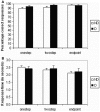Reasoning with linear orders: differential parietal cortex activation in sub-clinical depression. An FMRI investigation in sub-clinical depression and controls
- PMID: 25646078
- PMCID: PMC4298224
- DOI: 10.3389/fnhum.2014.01061
Reasoning with linear orders: differential parietal cortex activation in sub-clinical depression. An FMRI investigation in sub-clinical depression and controls
Abstract
The capacity to learn new information and manipulate it for efficient retrieval has long been studied through reasoning paradigms, which also has applicability to the study of social behavior. Humans can learn about the linear order within groups using reasoning, and the success of such reasoning may vary according to affective state, such as depression. We investigated the neural basis of these latter findings using functional neuroimaging. Using BDI-II criteria, 14 non-depressed (ND) and 12 mildly depressed volunteers took part in a linear-order reasoning task during functional magnetic resonance imaging. The hippocampus, parietal, and prefrontal cortices were activated during the task, in accordance with previous studies. In the learning phase and in the test phase, greater activation of the parietal cortex was found in the depressed group, which may be a compensatory mechanism in order to reach the same behavioral performance as the ND group, or evidence for a different reasoning strategy in the depressed group.
Keywords: fMRI; reasoning; sub-clinical depression.
Figures





Similar articles
-
Effective Connectivity of the Fronto-Parietal Network during the Tangram Task in a Natural Environment.Neuroscience. 2019 Dec 1;422:202-211. doi: 10.1016/j.neuroscience.2019.09.021. Epub 2019 Nov 1. Neuroscience. 2019. PMID: 31682954
-
Trait anxiety and neural efficiency of abstract reasoning: An fMRI investigation.J Biosci. 2018 Dec;43(5):877-886. J Biosci. 2018. PMID: 30541948
-
[Different patterns of brain activation between patients of Alzheimer's disease with and without depression: a functional MRI study during emotion Stroop task].Zhonghua Yi Xue Za Zhi. 2007 Apr 3;87(13):885-8. Zhonghua Yi Xue Za Zhi. 2007. PMID: 17650397 Chinese.
-
Brain activation during processing of genuine facial emotion in depression: Preliminary findings.J Affect Disord. 2018 Jan 1;225:91-96. doi: 10.1016/j.jad.2017.07.049. Epub 2017 Jul 27. J Affect Disord. 2018. PMID: 28802727 Review.
-
Integrated technology for evaluation of brain function and neural plasticity.Phys Med Rehabil Clin N Am. 2004 Feb;15(1):263-306. doi: 10.1016/s1047-9651(03)00124-4. Phys Med Rehabil Clin N Am. 2004. PMID: 15029909 Review.
Cited by
-
Hormonal regulation of circuit function: sex, systems and depression.Biol Sex Differ. 2019 Feb 28;10(1):12. doi: 10.1186/s13293-019-0226-x. Biol Sex Differ. 2019. PMID: 30819248 Free PMC article. Review.
-
Partially dissociative role of the left inferior frontal gyrus and left dorsolateral prefrontal cortex in reasoning.PLoS One. 2024 Dec 2;19(12):e0312919. doi: 10.1371/journal.pone.0312919. eCollection 2024. PLoS One. 2024. PMID: 39621731 Free PMC article.
References
-
- Brzezicka A. (2013). Integrative deficits in depression and in negative mood states as a result of fronto-parietal network dysfunctions. Acta Neurobiol. Exp. 73, 313–325. - PubMed
LinkOut - more resources
Full Text Sources
Other Literature Sources

